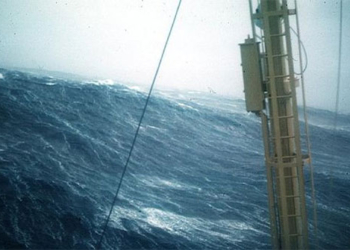Marine biologist Oddo has confirmed through decades of observation that squid can indeed fly over the surface of the sea for a brief period, and he was the first scientist to observe flying squid in an experiment.
Specifically, flying squid actually glide in the air just above the surface of the sea. In 1970, he released a group of squid into a seawater tank in the laboratory to observe their habits. The next day, he found several squid outside the tank, including one that had died from dehydration. How did these squid get out of the tank?

Until now, there have been many rumors and witnesses claiming to have seen large groups of flying squid over the sea. However, up to this point, no one has been able to prove and validate that squid can fly. Nonetheless, researchers at Hokkaido University have discovered a subspecies of squid capable of flight. This research was published in the journal Marine Biology.
To prevent a similar incident from happening again, the laboratory staff lowered the water level in the tank to 1 meter. After turning off the lights, they monitored through observation equipment to see if the squid would escape the tank again.
As expected, when the lights were turned off, the group of squid began to jump out of the water and soar into the air, resembling fighter jets taking off. Most of the squid were able to safely jump back into the tank, but a few remained outside.
When Oddo returned to the laboratory and turned on the lights, the squid stopped moving. After extensive research and gaining a deeper understanding of squid behavior, Oddo realized that squid not only propel themselves into the air but can also glide for a certain distance over the surface of the sea.

The research team captured images of about 20 squid flying together over the sea.
However, the flight path of squid is random and difficult to observe, making research in this aspect extremely challenging. Since the early 1890s, the first recorded observation of flying squid was made, and after more than 130 years, scientists have only observed flying squid events over ten times.
When squid are in flight, they use their fins as “wings” at the front of their bodies and twist their tentacles into a fan shape to create “wings” at the back. Over a decade ago, Japanese scientists photographed flying squid in waters near Japan, and these images clearly illustrated how squid fly.

It is hypothesized that squid flying into the air is a way to evade underwater predators. However, the question remains: when escaping from underwater threats, do squid “accidentally” encounter seabirds?
The two pairs of “wings” at the front and back provide propulsion for the squid, and some squid can glide over 10 meters. In the mid-1970s, Norwegian explorer Thor witnessed a squid glide at least 50 meters before falling back into the sea while crossing the Pacific Ocean on a raft.
Oddo realized that squid can control their bodies while flying in the air, possibly because they swim in a similar manner in the sea, and these flights are simply an extension of the squid’s swimming behavior.

The transition from swimming underwater to flying for this subspecies of squid is described in four stages: thrusting down, launching into the air, gliding, and diving down. When swimming, squid open their gills and move with the water current, then they use the thrust from the water surface to “burst” upwards. Once they leap out of the water, they can glide at a speed of 11.2 m/s, maintaining aerial status for about 3 seconds and traveling up to 30 meters with each flight.
Squid can also perform subtle movements while in flight to adjust their flying posture. Some squid will suddenly whip their tentacles backward and their fins down while flying, stopping their glide and falling back into the sea.
The take-off method of flying squid is also completely different from that of flying fish. Before take-off, flying fish quickly slap the surface of the water with their tails to gain momentum, while squid expel water from their bodies to create thrust.
In the mid-1960s, someone captured an image of a 1.2-meter-long American red squid, weighing about 40 kg, flying from underwater into the air, but the squid only glided about two meters. Compared to smaller squid, this distance is quite short.

The take-off method of flying squid is also completely different from that of flying fish.
Smaller squid have more developed propulsion systems; they can launch themselves to a certain height, and when they reach a specific initial speed, they can begin to glide long distances, with some species capable of launching themselves to heights of 6 meters above sea level.
Why have squid developed flying skills? Scientists have discovered that squid switch from swimming to flying when they are frightened or trying to evade predators, but Oddo believes there are many more reasons why squid fly beyond just these threats.

Giant squid.
Oddo found that the flying speed of squid is nearly six times faster than their swimming speed underwater, and once launched into the air, they can glide a long distance without expending energy. This energy-efficient mode of movement allows them to move quickly over short periods.
Squid are migratory creatures, and during migration, they expend a lot of energy, but they only have a small amount of stored fat in their bodies. They rely on the limited energy produced by their fat reserves for long-distance migration, and thus flying is a way for them to optimize their energy usage.
Scientists are uncertain whether all types of squid can fly. They are currently attempting to study squid more deeply by tagging them with tracking devices. It is believed that with the latest technology, scientists could uncover more unknown and miraculous abilities of squid.





















































